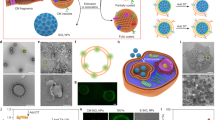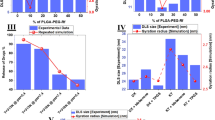Abstract
Controlling the cellular interaction and internalization of polymer-modified nanoparticles (NPs) is of central importance to the development of promising nanomedicines. Here, we describe the use of synthetic polypeptides for NP surface coating and regulation of their cellular uptake behaviors by simply switching the conformation and anchoring orientation. Our results show that gold NPs (AuNPs) coated with a helical poly(γ-(2-(2-(2-methoxyethoxy)ethoxy)ethoxy)esteryl L-glutamate) (L-P(EG3Glu)50) from the C-terminus ((L-C)-AuNPs) exhibit greater zeta potential and more cellular uptake (2.0–5.5 fold higher) than those coated with the same polypeptide but anchored from the N-terminus ((L-N)-AuNPs), or from both the C- and N-terminus at a 1/1 molar ratio ((L-C/L-N)-AuNPs). A similar orientation-regulated cellular internalization pattern is observed in D-P(EG3Glu)50 but not the unstructured DL-P(EG3Glu)50-modified AuNPs, suggesting an important and universal role of the helix-derived macrodipole in cellular uptake. Moreover, this orientation-governed internalization is successfully reproduced in P(EG3Glu)50-coated gold nanorods (AuNRs), and applied to the design of doxorubicin-loaded polypeptide micelles. Simulation study offers time-resolved insights regarding the NP–membrane interactions and membrane remodeling. Thus, our study provides a delicate way of regulating the surface chemistry of NPs and the subsequent NP–cell interactions. Moreover, the results highlight the uniqueness of polypeptides in NP surface engineering, and urge a more careful consideration on the polymer orientation effect.

Similar content being viewed by others
References
Saha, K.; Agasti, S. S.; Kim, C.; Li, X. N.; Rotello, V. M. Gold nanoparticles in chemical and biological sensing. Chem. Rev. 2012, 112, 2739–2779.
Chinen, A. B.; Guan, C. M.; Ferrer, J. R.; Barnaby, S. N.; Merkel, T. J.; Mirkin, C. A. Nanoparticle probes for the detection of cancer biomarkers, cells, and tissues by fluorescence. Chem. Rev. 2015, 115, 10530–10574.
Kim, D.; Kim, J.; Park, Y. I.; Lee, N.; Hyeon, T. Recent development of inorganic nanoparticles for biomedical imaging. ACS Cent. Sci. 2018, 4, 324–336.
Dong, H.; Du, S. R.; Zheng, X. Y.; Lyu, G. M.; Sun, L. D.; Li, L. D.; Zhang, P. Z.; Zhang, C.; Yan, C. H. Lanthanide nanoparticles: From design toward bioimaging and therapy. Chem. Rev. 2015, 115, 10725–10815.
Lane, L. A.; Qian, X. M.; Nie, S. M. SERS nanoparticles in medicine: From label-free detection to spectroscopic tagging. Chem. Rev. 2015, 115, 10489–10529.
Björnmalm, M.; Thurecht, K. J.; Michael, M.; Scott, A. M.; Caruso, F. Bridging bio-nano science and cancer nanomedicine. ACS Nano 2017, 11, 9594–9613.
Pelaz, B.; Alexiou, C.; Alvarez-Puebla, R. A.; Alves, F.; Andrews, A. M.; Ashraf, S.; Balogh, L. P.; Ballerini, L.; Bestetti, A.; Brendel, C. et al. Diverse applications of nanomedicine. ACS Nano 2017, 11, 2313–2381.
Yang, X.; Yang, M. X.; Pang, B.; Vara, M.; Xia, Y. N. Gold nanomaterials at work in biomedicine. Chem. Rev. 2015, 115, 10410–10488.
Li, S. X.; Feng, X. R.; Wang, J. X.; He, L.; Wang, C. X.; Ding, J. X.; Chen, X. S. Polymer nanoparticles as adjuvants in cancer immunotherapy. Nano Res. 2018, 11, 5769–5786.
Behzadi, S.; Serpooshan, V.; Tao, W.; Hamaly, M. A.; Alkawareek, M. Y.; Dreaden, E. C.; Brown, D.; Alkilany, A. M.; Farokhzad, O. C.; Mahmoudi, M. Cellular uptake of nanoparticles: Journey inside the cell. Chem. Soc. Rev. 2017, 46, 4218–4244.
Zhao, F.; Zhao, Y.; Liu, Y.; Chang, X. L.; Chen, C. Y.; Zhao, Y. L. Cellular uptake, intracellular trafficking, and cytotoxicity of nanomaterials. Small 2011, 7, 1322–1337.
Verma, A.; Stellacci, F. Effect of surface properties on nanoparticle–cell interactions. Small 2010, 6, 12–21.
Jiang, W.; Kim, B. Y. S.; Rutka, J. T.; Chan, W. C. W. Nanoparticlemediated cellular response is size-dependent. Nat. Nanotechnol. 2008, 3, 145–150.
Tang, L.; Yang, X. J.; Yin, Q.; Cai, K. M.; Wang, H.; Chaudhury, I.; Yao, C.; Zhou, Q.; Kwon, M.; Hartman, J. A. et al. Investigating the optimal size of anticancer nanomedicine. Proc. Natl. Acad. Sci. USA 2014, 111, 15344–15349.
Mosquera, J.; García, I.; Liz-Marzán, L. M. Cellular uptake of nanoparticles versus small molecules: A matter of size. Acc. Chem. Res. 2018, 51, 2305–2313.
Chithrani, B. D.; Chan, W. C. W. Elucidating the mechanism of cellular uptake and removal of protein-coated gold nanoparticles of different sizes and shapes. Nano Lett. 2007, 7, 1542–1550.
Li, Y.; Kröger, M.; Liu, W. K. Shape effect in cellular uptake of PEGylated nanoparticles: Comparison between sphere, rod, cube and disk. Nanoscale 2015, 7, 16631–16646.
Verma, A.; Uzun, O.; Hu, Y. H.; Hu, Y.; Han, H. S.; Watson, N.; Chen, S.; Irvine, D. J.; Stellacci, F. Surface-structure-regulated cell-membrane penetration by monolayer-protected nanoparticles. Nat. Mater. 2008, 7, 588–595.
Xue, J. X.; Guan, Z.; Lin, J. P.; Cai, C. H.; Zhang, W. J.; Jiang, X. Q. Cellular internalization of rod-like nanoparticles with various surface patterns: Novel entry pathway and controllable uptake capacity. Small 2017, 13, 1604214.
Mochida, Y.; Cabral, H.; Miura, Y.; Albertini, F.; Fukushima, S.; Osada, K.; Nishiyama, N.; Kataoka, K. Bundled assembly of helical nanostructures in polymeric micelles loaded with platinum drugs enhancing therapeutic efficiency against pancreatic tumor. ACS Nano 2014, 8, 6724–6738.
Hühn, D.; Kantner, K.; Geidel, C.; Brandholt, S.; De Cock, I.; Soenen, S. J. H.; Rivera_Gil, P.; Montenegro, J. M.; Braeckmans, K.; Müllen, K. et al. Polymer-coated nanoparticles interacting with proteins and cells: Focusing on the sign of the net charge. ACS Nano 2013, 7, 3253–3263.
Hauck, T. S.; Ghazani, A. A.; Chan, W. C. W. Assessing the effect of surface chemistry on gold nanorod uptake, toxicity, and gene expression in mammalian cells. Small 2008, 4, 153–159.
Wang, X. Y.; Wang, M. Z.; Lei, R.; Zhu, S. F.; Zhao, Y. L.; Chen, C. Y. Chiral surface of nanoparticles determines the orientation of adsorbed transferrin and its interaction with receptors. ACS Nano 2017, 11, 4606–4616.
Sun, J. S.; Zhang, L.; Wang, J. L.; Feng, Q.; Liu, D. B.; Yin, Q. F.; Xu, D. Y.; Wei, Y. J.; Ding, B. Q.; Shi, X. H. et al. Tunable rigidity of (polymeric core)–(lipid shell) nanoparticles for regulated cellular uptake. Adv. Mater. 2015, 27, 1402–1407.
Borase, T.; Heise, A. Hybrid nanomaterials by surface grafting of synthetic polypeptides using N-carboxyanhydride (NCA) polymerization. Adv. Mater. 2016, 28, 5725–5731.
Song, Z. Y.; Han, Z. Y.; Lv, S. X.; Chen, C. Y.; Chen, L.; Yin, L. C.; Cheng, J. J. Synthetic polypeptides: From polymer design to supramolecular assembly and biomedical application. Chem. Soc. Rev. 2017, 46, 6570–6599.
Shen, Y.; Fu, X. H.; Fu, W. X.; Li, Z. B. Biodegradable stimuli-responsive polypeptide materials prepared by ring opening polymerization. Chem. Soc. Rev. 2015, 44, 612–622.
Deming, T. J. Synthesis of side-chain modified polypeptides. Chem. Rev. 2016, 116, 786–808.
Guyon, L.; Lepeltier, E.; Passirani, C. Self-assembly of peptide-based nanostructures: Synthesis and biological activity. Nano Res. 2018, 11, 2315–2335.
Lindgren, M.; Hällbrink, M.; Prochiantz, A.; Langel, Ü. Cell-penetrating peptides. Trends Pharmacol. Sci. 2000, 21, 99–103.
Petsko, G. A.; Ringe, D. Protein Structure and Function; New Science Press: London, 2004.
Galoppini, E.; Fox, M. A. Effect of the electric field generated by the helix dipole on photoinduced intramolecular electron transfer in dichromophoric a-helical peptides. J. Am. Chem. Soc. 1996, 118, 2299–2300.
Song, Z. Y.; Fu, H. L.; Wang, R. B.; Pacheco, L. A.; Wang, X.; Lin, Y.; Cheng, J. J. Secondary structures in synthetic polypeptides from Ncarboxyanhydrides: Design, modulation, association, and material applications. Chem. Soc. Rev. 2018, 47, 7401–7425.
Niwa, M.; Kuwagaki, Y.; Yamaguchi, S.; Higashi, N. Effect of the helix macrodipole on surface-initiated N-carboxyanhydride polymerization on gold. Angew. Chem. 2003, 115, 1883–1885.
Worley, C. G.; Linton, R. W.; Samulski, E. T. Electric-field-enhanced selfassembly of.alpha.-helical polypeptides. Langmuir 1995, 11, 3805–3810.
Niwa, M.; Morikawa, M. A.; Higashi, N. Controllable orientation of helical poly(L-glutamic acid) rods through macrodipole interaction on gold surfaces and vectorial electron transfer. Angew. Chem., Int. Ed. 2000, 39, 960–963.
Jaworek, T.; Neher, D.; Wegner, G.; Wieringa, R. H.; Schouten, A. J. Electromechanical properties of an ultrathin layer of directionally aligned helical polypeptides. Science 1998, 279, 57–60.
Chang, Y. C.; Frank, C. W.; Forstmann, G. G.; Johannsmann, D. Quadrupolar and polar anisotropy in end-grafted a-helical poly(?-benzyl-L-glutamate) on solid substrates. J. Chem. Phys. 1999, 111, 6136–6143.
Whitesell, J. K.; Chang, H. K. Surface oriented polymers for nonlinear optics. Mol. Cryst. Liq. Cryst. Sci. Technol. Sect. A 1994, 240, 251–258.
Zhang, C.; Yuan, J. S.; Lu, J. H.; Hou, Y. Q.; Xiong, W.; Lu, H. From neutral to zwitterionic poly(a-amino acid) nonfouling surfaces: Effects of helical conformation and anchoring orientation. Biomaterials 2018, 178, 728–737.
Chen, C. Y.; Wang, Z. H.; Li, Z. B. Thermoresponsive polypeptides from PEGylated poly-L-glutamates. Biomacromolecules 2011, 12, 2859–2863.
Frens, G. Controlled nucleation for the regulation of the particle size in monodisperse gold suspensions. Nat. Phys. Sci. 1973, 241, 20–22.
Sau, T. K.; Murphy, C. J. Seeded high yield synthesis of short Au nanorods in aqueous solution. Langmuir 2004, 20, 6414–6420.
Murphy, C. J.; Sau, T. K.; Gole, A. M.; Orendorff, C. J.; Gao, J. X.; Gou, L. F.; Hunyadi, S. E.; Li, T. Anisotropic metal nanoparticles: Synthesis, assembly, and optical applications. J. Phys. Chem. B 2005, 109, 13857–13870.
Groot, R. D.; Warren, P. B. Dissipative particle dynamics: Bridging the gap between atomistic and mesoscopic simulation. J. Chem. Phys. 1997, 107, 4423–4435.
Yang, K.; Ma, Y. Q. Computer simulation of the translocation of nanoparticles with different shapes across a lipid bilayer. Nat. Nanotechnol. 2010, 5, 579–583.
Bonduelle, C. Secondary structures of synthetic polypeptide polymers. Polym. Chem. 2018, 9, 1517–1529.
Li, G. Z.; Cheng, G.; Xue, H.; Chen, S. F.; Zhang, F. B.; Jiang, S. Y. Ultra low fouling zwitterionic polymers with a biomimetic adhesive group. Biomaterials 2008, 29, 4592–4597.
Banerjee, I.; Pangule, R. C.; Kane, R. S. Antifouling coatings: Recent developments in the design of surfaces that prevent fouling by proteins, bacteria, and marine organisms. Adv. Mater. 2011, 23, 690–718.
Matsuura, K.; Ohno, K.; Kagaya, S.; Kitano, H. Carboxybetaine polymerprotected gold nanoparticles: High dispersion stability and resistance against non-specific adsorption of proteins. Macromol. Chem. Phys. 2007, 208, 862–873.
Yu, X. F.; Liu, Z. H.; Janzen, J.; Chafeeva, I.; Horte, S.; Chen, W.; Kainthan, R. K.; Kizhakkedathu, J. N.; Brooks, D. E. Polyvalent choline phosphate as a universal biomembrane adhesive. Nat. Mater. 2012, 11, 468–476.
Yameen, B.; Choi, W. I.; Vilos, C.; Swami, A.; Shi, J.; Farokhzad, O. C. Insight into nanoparticle cellular uptake and intracellular targeting. J. Control. Release 2014, 190, 485–499.
Tian, F. L.; Zhang, X. R.; Dong, W. How hydrophobic nanoparticles aggregate in the interior of membranes: A computer simulation. Phys. Rev. E 2014, 90, 052701.
Yue, T. T.; Zhang, X. R. Molecular understanding of receptor-mediated membrane responses to ligand-coated nanoparticles. Soft Matter 2011, 7, 9104–9112.
Hou, Y. Q.; Zhou, Y.; Wang, H.; Sun, J. L.; Wang, R. J.; Sheng, K.; Yuan, J. S.; Hu, Y. L.; Chao, Y.; Liu, Z.; Lu, H. Therapeutic protein PEPylation: The helix of nonfouling synthetic polypeptides minimizes antidrug antibody generation. ACS C ent. Sci., in press, DOI: 10.1021/acscentsci.8b00548.
Acknowledgments
Financial supports from the National Key Research and Development Program of China (No. 2016YFA0201400) and the National Natural Science Foundation of China (No. 21722401) are gratefully acknowledged.
Author information
Authors and Affiliations
Corresponding authors
Electronic supplementary material
Rights and permissions
About this article
Cite this article
Zhang, C., Lu, J., Tian, F. et al. Regulation of the cellular uptake of nanoparticles by the orientation of helical polypeptides. Nano Res. 12, 889–896 (2019). https://doi.org/10.1007/s12274-019-2319-6
Received:
Revised:
Accepted:
Published:
Issue Date:
DOI: https://doi.org/10.1007/s12274-019-2319-6




